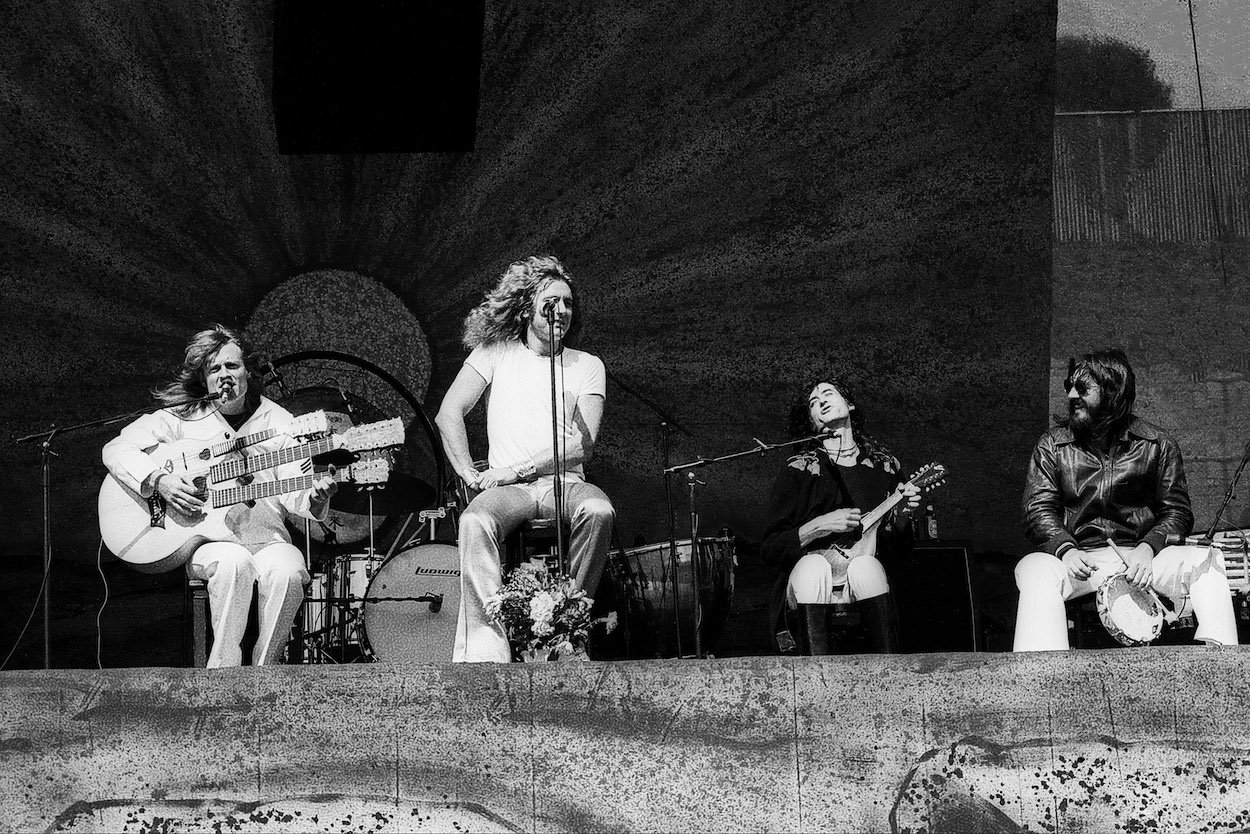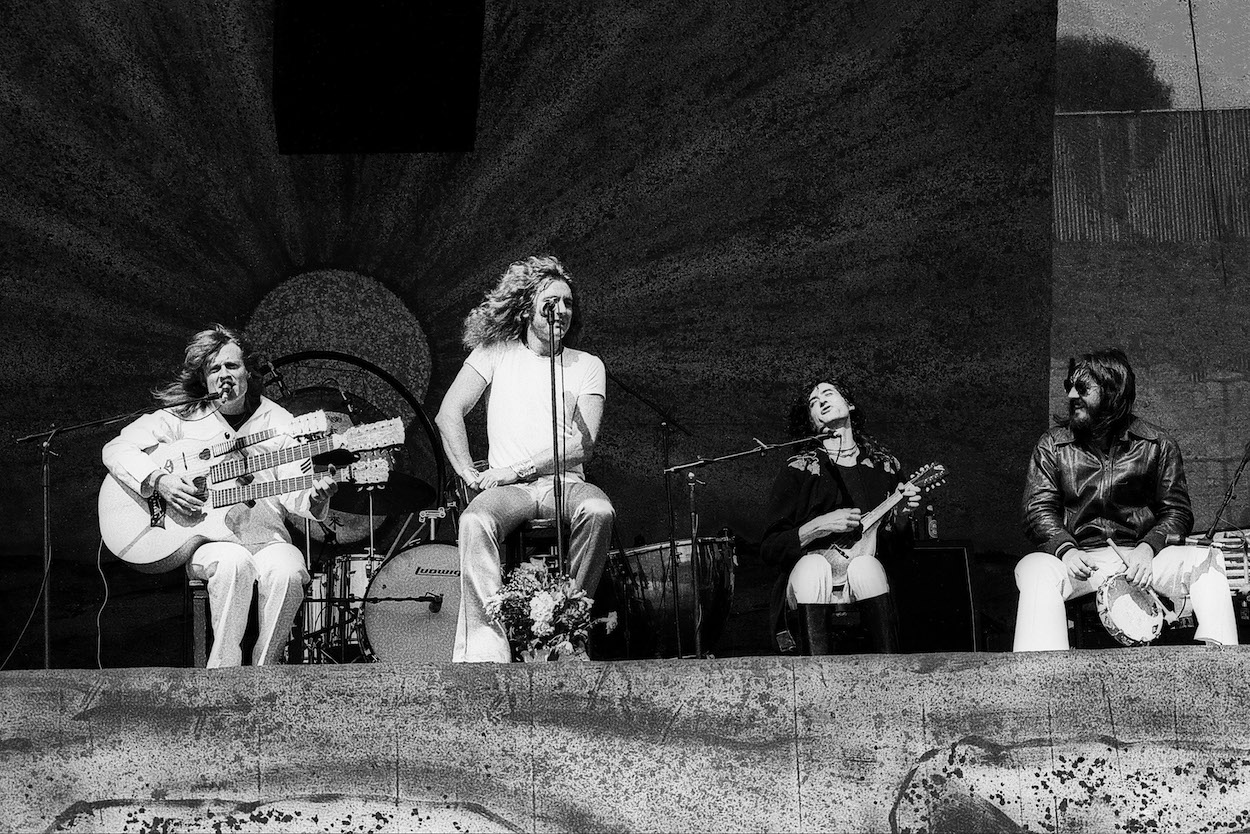
The 5 Most Experimental Led Zeppelin Songs
It didn’t take Led Zeppelin long to find a devoted following after they debuted in 1968. A few fellow musicians hated the band, but fans loved them. Drummer John Bonham explained Zep’s popularity succinctly — they placed the music above everything else and delivered tunes fans wanted to hear. The band burst out of the gate playing (more or less) straightforward heavy blues, but these five Led Zeppelin songs showed an experimental side that proved they had a lot more to offer.

1. ‘Whole Lotta Love’
Jimmy Page’s chugging call-and-response riff and Robert Plant’s libido-fueled lyrics don’t necessarily cover any ground the band hadn’t tread on its debut. But it didn’t take long for Led Zeppelin II’s first track to veer off the beaten path.
All you have to do is wait about 35 seconds to hear how “Whole Lotta Love” is one of the most experimental Led Zeppelin songs.
Page’s backmasked guitar — a backward effect that sees the note’s echo precede the playing of the note — makes its first appearance on a Led Zeppelin record. The band ups the ante at the 1:20 mark. The psychedelic freakout in the middle of the song — featuring Bonham’s reverbed drums, faint tablas in the background, Page’s turn on a theremin — was unlike anything the band did before (or after).
2. ‘Hats off to Roy Harper’
Page and Plant needed only two takes to finish Led Zeppelin III closer “Hats off to Roy Harper.” That wasn’t out of the ordinary for the band. The whiplash-inducing acoustic slide guitar is unique among Zep songs, but that’s not the only thing that makes it an experimental tune.
Plant’s vocals do.
He plugged his microphone into the amp’s tremolo channel while singing. Instead of treating Plant’s vocals with a production effect, he and Page took the signal from the amp and committed it to tape while the guitarist played next to him. The singer got inventive with it starting around the 1:50 mark. He holds a note that wavers thanks to the tremolo affecting the wave amplification of the signal.
3. ‘Boogie With Stu’
Originally recorded during the Led Zeppelin IV sessions, the band kept this one under wraps until 1975’s Physical Graffiti. It’s one of Led Zeppelin’s underrated songs. “Boogie With Stu” is also one of their most experimental tracks for one simple reason: it was the first time they tackled roadhouse rockabilly music.
Ian Stewart (perhaps better known as The Rolling Stones’ sometimes piano player) plays a rollicking piano line on an out-of-tune instrument. Led Zeppelin includes some of their other influences — a blues riff with and a folk-inspired solo on top of an echoing drum beat — on the song. Still, this was the first time their fans heard their southern American rock influence so strongly on an album.
Led Zeppelin seemed to enjoy dabbling in rockabilly — their next two studio albums included songs similar to “Boogie With Stu.” Presence gave us the Elvis Presley-like “Candy Store Rock” while In Through the Out Door included the back-porch jam “Hot Dog.”
4. ‘Wearing and Tearing’
Led Zeppelin had a reputation as a heavy band early in their career. Yet they never hid their love for folk, country, and world music. Still, the In Through the Out Door leftover “Wearing and Tearing” might have been their heaviest moment.
Page forgoes his normally flowing guitar for a pounding and punchy riff that might be closer to Motörhead than to anything in Led Zeppelin’s catalog. Their supposed response to punk rock was all wrong. Still, Page’s playing makes it one of Led Zeppelin’s most experimental songs.
5. ‘Hey Hey What Can I Do’
Page’s folk-tinged acoustic riffing, John Paul Jones’ sublime bass work, and Plant’s lyrics about love gone sour were nothing new. So what makes “Hey Hey What Can I Do” an experimental Led Zeppelin song? It’s the only time all four members sang on a song.
Page, Bonham, and Jones harmonize the “Hey hey what can I do?” and “Hey hey what can I say?” lyrics while Plant repeats his “Keep on” lyrics over them. You have to wait until the end of the song to hear the harmonization, but it’s worth it.
The Led Zeppelin III outtake was a B-side to the “Immigrant Song” single in the U.S., but it never appeared on an album until the 1990 box set.
The public pegged them as a heavy blues band, but these five experimental Led Zeppelin songs prove they had much more in their arsenal.
For more on the entertainment world and exclusive interviews, subscribe to Showbiz Cheat Sheet’s YouTube channel.


